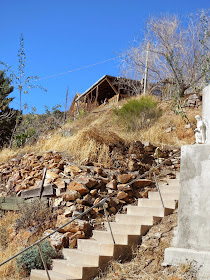
Directions: The Tortolita Mountains are an overlooked mountain range to the west of Tucson, Arizona. Visitors tend to stay in Saguaro National Park or hike in the Catalina Mountains. This is a mistake because the Tortolita Mountains are very scenic. From Interstate 10 take the Tangerine Road exit. Turn east, crossing the train tracks, and drive until you reach Dove Mountain Road. Turn left onto Dove Mountain and follow it until you reach a sign for the Ritz-Carlton Dove Mountain. This area has been built up significantly in the last five years. You will see signs for the Wild Burro Trailhead where there is a big parking lot.
Hike: Last year I hiked the Wild Mustang and Wild Burro Trails with my friend Nathan. The objective for todays hike was to hike the Alamo Springs tTail and then come back on the Wild Burro Trail. Total mileage was about nine miles with over 1500 feet. I started late in the morning and the temperature was already warm under the sun. I was glad I brought the six containers of water with me. There is not a lot of shade on the Alamo Trail but hikers can find some shade under Mesquite or Palo verde bushes. In the future I want to get started earlier in the day especially on this trail. When I arrived at Alamo Springs I returned to the parking lot via Wild Burro. On the way back I met two older gentlemen from Ohio who were geocaching in the mountains. They were following their GPS and wanted to go cross-country to the cache. I advised them that it would not be a wise decision because the Sonoran Desert is one of the most difficult deserts to hike off-trail in.




















































